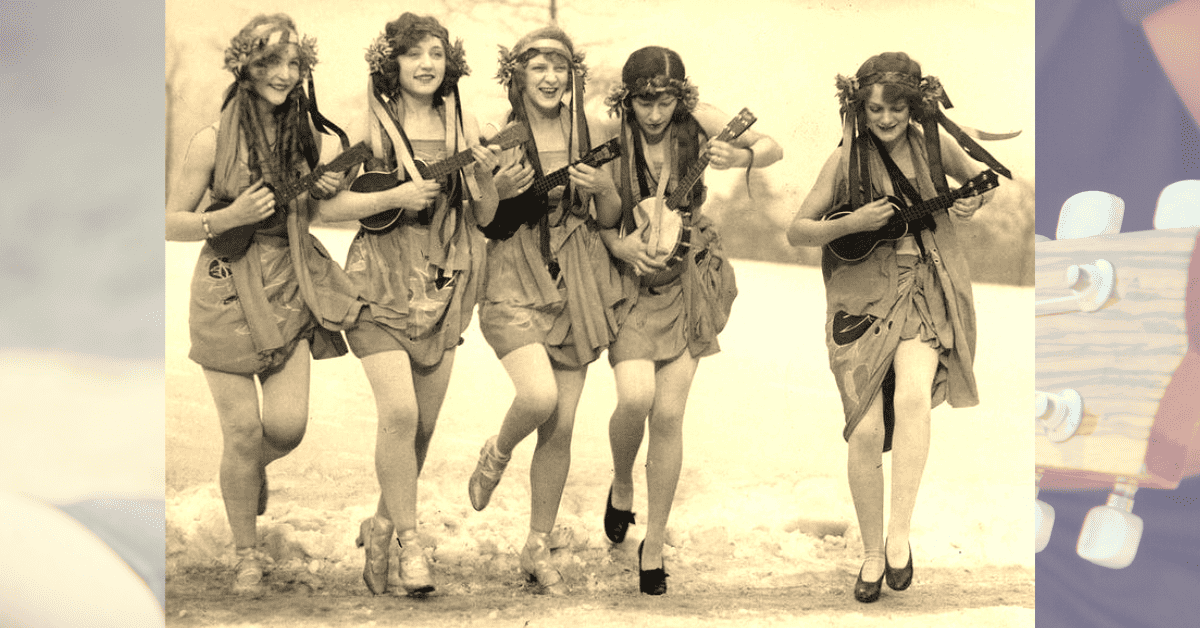Are you wondering why the ukulele gained worldwide popularity in the 20th century? Believe it or not, this unique instrument from Hawaii had a significant influence on global music during those years.
This article will take you on an exciting journey through the evolution of the ukulele’s fame in the last century, revealing its fascinating history and impact. Ready to explore what made four strings so enchanting?.
Key Takeaways
- The ukulele came from Hawaii. Portuguese woodworkers made it in the 19th century. It became popular because of its unique sound and easy play style.
- Tin Pan Alley musicians helped spread ukulele popularity across America in the early 20th century. Radio shows like “Hawaii Calls” also played a big part.
- There are several sizes and types of ukuleles, each with unique sounds. They can be tuned differently, too, for various music styles.
- The ukulele was popular internationally. Canada used it for education. Japan loved its affordability and ease, the UK saw wide audience participation due to its simplicity, while America embraced this instrument into their culture after exposure during a World Fair event in 1915.
- In the 20th century, jazz musicians started using the Ukulele more often, which resulted in increasing popularity worldwide even though there was a slight decline during the rock-and-roll era until the late 1990s when a resurgence in public interest happened because famous artists used it in their performances.
The Birth of the Ukulele

The ukulele was birthed in Hawaii, a product of Portuguese woodworkers’ ingenuity who adapted their traditional instruments to create this unique and distinctive one.
This is the story of the rise of ukulele popularity in the 20th century.
The Ukulele’s Portuguese Roots: What’s the Connection?
The ukulele’s journey began with Portuguese immigrants who brought instruments like the “machete” and “cavaquinho” to Hawaii.
These small, guitar-like instruments, integral to Portuguese music and culture, were the precursors to the modern ukulele.
Craftsmen native to Madeira, like Manuel Nunes, José do Espirito Santo, and Augusto Dias, are credited as the original makers of the iconic ukulele, combining elements from their traditional instruments with the needs and tastes of the Hawaiian musical scene.
When these Portuguese immigrants arrived in Hawaii, they introduced not just their instruments but also their musical style, which played a significant role in the development of Hawaiian music.
The braguinha, a smaller variant, particularly influenced the ukulele’s design and construction, contributing to its unique sound.
Hawaii: The Origins of the Ukulele
The ukulele’s story has its roots in Hawaii, deeply intertwined with the island’s history and culture. Portuguese immigrants introduced this instrument to Hawaii in the late 19th century, sparking an enduring love affair between locals and this small four-stringed marvel.
1879: The Year the Ukulele Was Introduced to Hawaii
The ukulele was officially introduced to Hawaii in 1879 when Portuguese immigrants from Madeira arrived to work in the sugar cane fields.
These immigrants brought their traditional stringed instruments, which captivated the Hawaiian locals, including King David Kalakaua, who would become a significant figure in the ukulele’s history.
The Hawaiian Gazette reported on this musical phenomenon, describing the locals’ fascination with these “guitar-like” instruments.
The integration of these instruments into Hawaiian culture was rapid and profound, influencing the creation of a unique musical identity in the region.
Three prominent immigrants – Manuel Nunes, José do Espírito Santo, and Augusto Dias emerged as distinguished creators of original ukuleles in Hawaii. So accepted was the Ukulele into Hawaiian society that even King David Kalakaua himself played it often, further adding to its popularity within the region.
The iconic name ‘ukulele’ translates to ‘jumping flea’ owing to quick finger movements while playing. Over time, the Hawaiian-made versions of these musical instruments gained a distinct local flavor, setting them apart from their European counterparts.
Role of Portuguese Woodworkers
Portuguese woodworkers left a lasting legacy in Hawaii with their exceptional skills and innovative ideas. They introduced the ukulele, which became an intrinsic part of Hawaiian culture and music.
Skilled artisans like Manuel Nunes, José do Espírito Santo, and Augusto Dias are credited as the pioneers of this instrument. These craftsmen reimagined traditional Portuguese instruments into what we now know as the ukulele.
Through their craftsmanship, Portuguese woodworkers helped catapult the popularity of the ukulele among locals in Hawaii. Their collective efforts allowed this four-stringed instrument to gain recognition not just on the islands but also throughout much of The Great Depression-era America.
Indeed, without them, we might not have had cultural icons such as Cliff ‘Ukulele Ike’ Edwards or George Formby strumming away at these pint-sized wonders.
ukulele popularity in the 20th century
In the early 20th century, the ukulele gained immense popularity among the emerging middle class due to its affordability and simplistic design.
Influenced by Tin Pan Alley music publishers, arrangers, songwriters, and famed artists like May Singhi Breen, Rudy Vallee, Johnny Marvin, and Cliff Edwards (Ukulele Ike), this small string instrument found a spot in American households.
As early as 1901, musician Anthony Zabian performed on the ukulele at the Pan-American Exposition in Buffalo, N.Y.
But the turning point would come in 1915
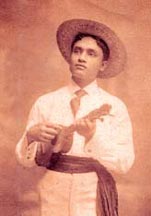
The Ukulele’s Mainland Debut: What Happened in 1915?
The year 1915 marked a turning point for the ukulele. With the Panama-Pacific International Exposition held in San Francisco, the Hawaiian Pavilion featured a ukulele ensemble, introducing the instrument to a broader American audience.
This event showcased Hawaiian culture and music, with the ukulele at the forefront, sparking a mainland craze for the instrument.
The captivating sound of the ukulele, along with its association with the alluring Hawaiian culture, caught the mainland’s imagination, setting off a craze that would continue for decades.
This event was critical in the ukulele’s history, as it transitioned from being an exotic feature in Hawaii to a mainstream musical instrument across the United States.
Its popularity in the continental U.S. ignited a demand for ukuleles, ukulele music books, and sheet music, establishing it as a staple of American popular music.
The radio broadcast of “Hawaii Calls” further spread the charm of Ukulele sounds across continents.
Popularity Among the Emerging Middle Class
The ukulele gained great admiration among the growing middle class in the early 20th century. This newfound popularity was largely due to its affordability and ease of play, making it a big hit with amateur musicians.
The instrument’s charm lay not just in its unique sound but also in its versatility – fitting perfectly into jazz ensembles or standing alone for solo performances. With more families having disposable income during this period, they opted for affordable entertainment like buying musical instruments such as ukuleles, which added fun and excitement to their lives without straining finances.
As a result, the ukulele became an emblematic icon of music culture within middle-class society across America.
Ukuleles in Popular Music: The Early Influencers?
In the early 20th century, the ukulele found its way into popular music, partly due to musicians like George Formby and “Ukulele Ike” (Cliff Edwards). These performers, among others, incorporated the ukulele into their music and performances, solidifying the instrument’s place in the world of popular music.
Formby, in particular, became synonymous with the banjo-ukulele (or banjolele), while Ukulele Ike was known for his unique singing and playing style.
Their contributions, along with Tin Pan Alley composers who included ukulele chords in their sheet music, helped maintain the instrument’s popularity even as musical tastes began to shift.
Influence of Tin Pan Alley
Tin Pan Alley, the hub of songwriting in New York City in the early 20th century, played a significant role in promoting the ukulele. Composers and musicians there took an interest in this Hawaiian novelty, incorporating its unique sound into their works.
Tin Pan Alley and the Ukulele: How Did Sheet Music Impact Its Popularity?
The ukulele’s golden era can be attributed to the prolific period of Tin Pan Alley, the collection of New York City music publishers and songwriters who dominated popular music in the late 19th and early 20th centuries. The ukulele became a favorite among these musicians, and its chords often featured prominently in sheet music of the time.
This exposure through popular sheet music brought it to countless households across America. Notably, Tin Pan Alley’s influence went beyond just sparking popularity; it played a key part in shaping American perception of this instrument as charmingly quirky and easy to learn.
The significance of this connection between the ukulele and Tin Pan Alley cannot be overstated—it laid the groundwork for a cultural revolution around this little four-stringed instrument that extends well into modern times.
Hawaii Calls: Spreading Ukulele Fame
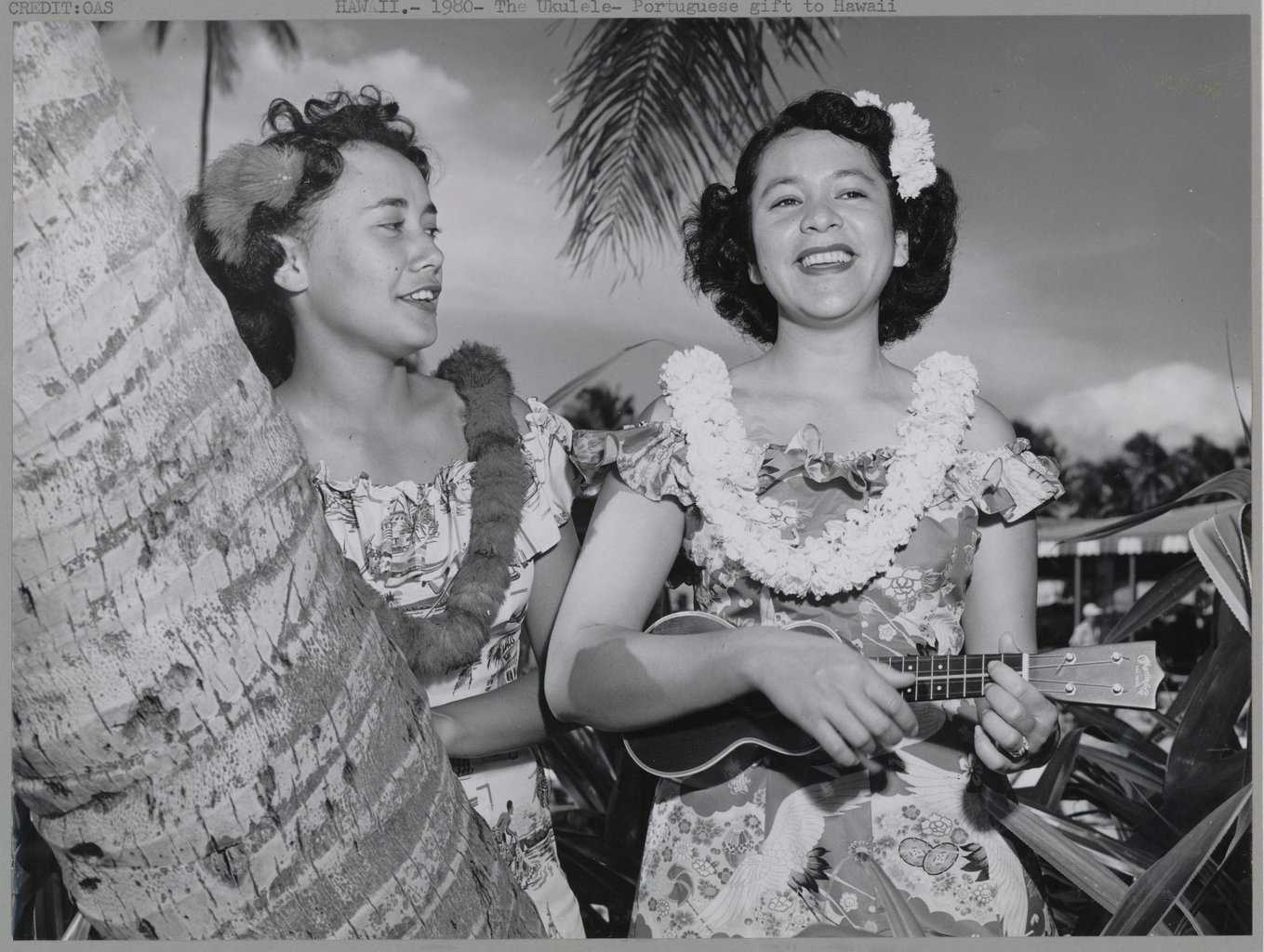
In the early 20th century, Hawaii spread ukulele fame far and wide. The Panama-Pacific International Exposition held in 1915 marked an important milestone in this journey. At this world fair, Hawaiian musicians mesmerized audiences with their exotic sounds and graceful hula dancing.
This cultural display played a pivotal role in popularizing the ukulele in the mainland United States.
Radio also contributed significantly to the rise of ukulele popularity. Programs like “Hawaii Calls” broadcast traditional Hawaiian music across America’s airwaves, further cementing its appeal.
Famous personalities from Arthur Godfrey to Marilyn Monroe used their star power to promote these charming little instruments on various media platforms, thus making Hawaii instrumental in spreading ukulele fame globally.
The Ukulele’s International Fame
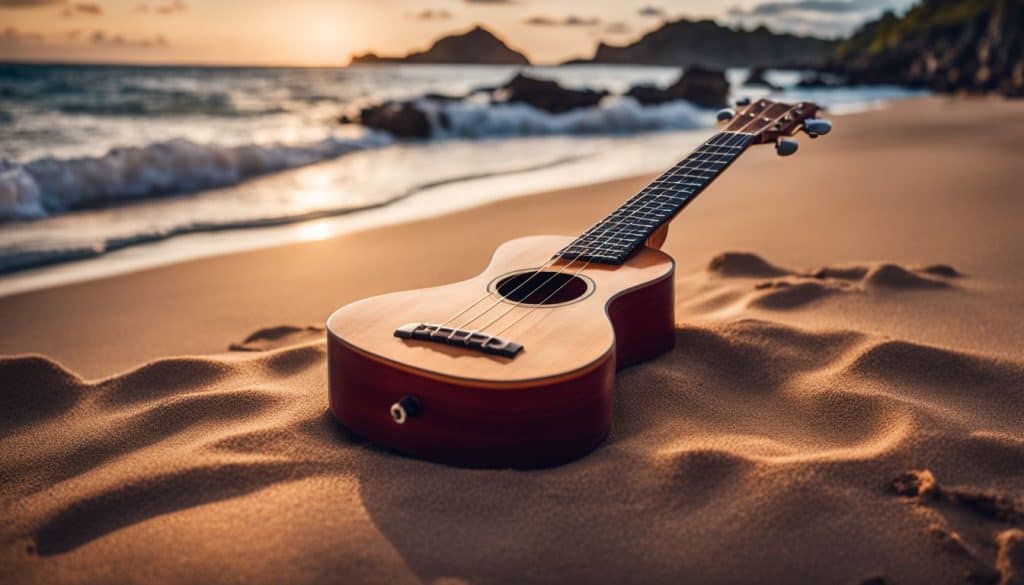
In this section, we explore how the ukulele found its way into various countries, such as Canada, Japan, the United Kingdom, and the United States, gaining international acclaim.
Popularity in Canada
Ukulele fever is not an isolated incident in Canada; its popularity has surged over the years. Schools across the country have embraced this musical instrument as a tool to enhance their music education programs.
To foster musical literacy among students, educators frequently incorporate ukuleles into lessons due to their user-friendly nature and affordability. The unmistakable appeal of the ukulele transcends cultural barriers and age groups, making it a favorite among Canadians of all backgrounds.
This widespread acceptance paints a vibrant picture of the role that this little instrument plays in shaping Canada’s richly diverse music scene.
Adoption in Japan
Japan embraced the ukulele in the 20th century, contributing to its international fame. The instrument’s affordability and the ease with which one could learn to play played crucial roles in its popularity.
Unfortunately, like many other places globally, Japan saw a slump in ukulele interest from the late 1960s till the late 1990s. However, Israel Kamakawiwo’ole’s soulful renditions of “Over the Rainbow” and “What a Wonderful World” breathed new life into this little four-stringed instrument, reigniting Japan’s love for it.
Influence in the United Kingdom
The ukulele’s rise to fame in the United Kingdom started with British musicians embracing this versatile instrument. Its easy-to-play nature opened doors for a wide audience, allowing many to participate in the joy of music-making regardless of prior experience.
The late 20th century saw a significant revival of the ukulele that dramatically impacted its popularity across UK, ensuring it remains a staple element within popular music today.
Spread Across the United States
The upsurge of the ukulele gained momentum in cities and towns all over America. Cultural hubs like San Francisco, New York, and Chicago saw a surge in popularity after the Panama–Pacific International Exposition in 1915.
This world fair showcased culture from Hawaii, including the enchanting sounds of this small stringed instrument.
Local music stores started to stock ukuleles as an affordable and accessible instrument for all ages. Schools began integrating it into their music education programs thanks to its simplicity and capacity to foster musical literacy.
By the late 20th century, despite a period of decline during the intense rock-and-roll era of the 60s, there was a noticeable revival spurred by influential musicians using this instrument in breakthrough performances.
Role in Popular Music of the 20th Century
The ukulele found its place in the music scene of the 20th century with a bang. In the Roaring Twenties, jazz musicians embraced the instrument, adding a unique sound to their upbeat tunes.
Throughout this era, also known as the Jazz Age, renowned composers and performers like Johnny Marvin and Cliff “Ukulele Ike” Edwards introduced the ukulele into mainstream popular music.
The trend continued into swing-era hits from the Glenn Miller Orchestra and even Django Reinhart’s gypsy jazz compositions. However, it was during World War II that army bands began using ukuleles to entertain troops, solidifying their role in popular music.
After experiencing a decline in popularity post-World War II, when rock’n’roll reigned supreme, and guitars became more desirable instruments for budding musicians.
Israel Kamakawiwo’ole’s Influence
In the late 20th century, the public’s interest in ukuleles reawakened significantly. Much of this renewed enthusiasm can be attributed to Israel Kamakawiwo’ole’s captivating versions of “Over the Rainbow” and “What a Wonderful World,”
His performances showcased the alluring beauty of Hawaii and paved the way for what followed: a lasting global fascination with this powerful little symbol of Hawaiian culture.
Influence on Popular Art
The ukulele has left an indelible mark on popular art across the globe. In visual arts, it often appears as a symbol of joy and tropical leisure, featuring in countless paintings, illustrations, posters, and murals.
Notably, its influence also extends to the world of performance art. A variety of comedians incorporate ukulele into their acts for a unique twist. Its diverse applications in different forms of art showcase the instrument’s versatility beyond music-making alone.
The Evolution of the Ukulele
This section examines the key transformations of the ukulele, from its post-World War II developments to its brief period of decline, and finally, its reemergence and renewed popularity in recent times.
Post World War II Developments
The mid-20th century brought significant changes for the ukulele. Post World War II, there was a decline in its popularity, moving it from center stage to the periphery of popular music.
The rise of rock and roll and an increasing preference for the guitar strained its recognition in mainstream music circles. Despite this downturn, plastic ukuleles by manufacturers such as Mario Maccaferri gained traction due to their durability and affordability.
Television also played a role in keeping the ukulele alive, with entertainers like Arthur Godfrey, Lucille Ball, and Marilyn Monroe occasionally strumming on screen, reminding audiences of its unique charm.
The Dark Ages of the Ukulele
The late 1960s ushered in a period often referred to as the Dark Ages of the Ukulele. During this time, interest in the instrument dipped significantly compared to its roaring popularity earlier in the century.
The Rise and Fall: What Caused the Ukulele’s Varying Popularity?
Like many cultural phenomena, the ukulele’s popularity has experienced peaks and troughs. Its initial rise can be credited to its royal endorsement and introduction to the mainland U.S., but its novelty also led to periods of decline.
Several factors contributed to this decline, including changing music trends and a cultural shift away from Hawaiian-inspired melodies that had boosted ukulele sales for decades. The dominance of rock bands and electric guitars in popular music also played a part in sidelining the once-beloved ukulele.
Despite these challenges, love for this unique instrument never completely vanished, thanks to dedicated enthusiasts who kept playing it during these lean years. Artists like Tiny Tim in the 1960s and bands like the Ukulele Orchestra of Great Britain later on revived interest by incorporating the instrument into various music genres.
The Comeback of the Ukulele
In the late 1990s, the ukulele began to resurface in mainstream music culture. This surge of interest emerged largely due to Israel Kamakawiwo’ole’s mesmerizing tunes “Over the Rainbow” and “What a Wonderful World”.
These renditions not only revitalized the instrument but also introduced it to an entirely new generation. Simultaneously, up north in Canada, educators started using this four-stringed instrument as an effective tool for teaching musical literacy.
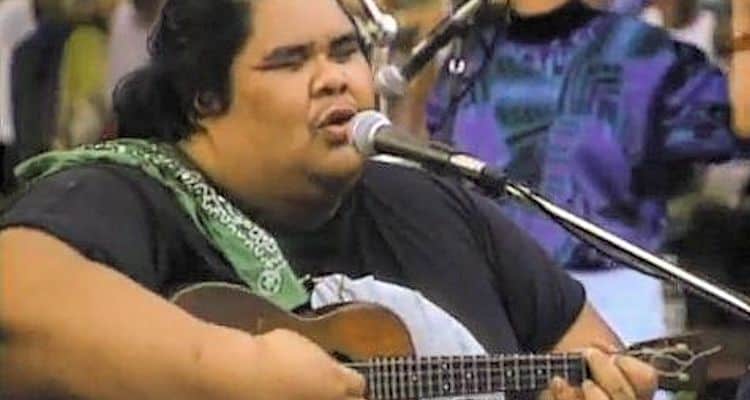
The compact size and easy-to-learn chords of the ukulele made it ideal for classroom scenarios, helping students understand principles like melody, harmony, rhythm, and dynamics. The revival continues today, with each strum echoing its rich history while defining its place in contemporary soundscapes.
Modern Ukulele Virtuosos: Who Are They?
Today, several virtuosos are pushing the ukulele beyond its traditional boundaries. Jake Shimabukuro is one such master whose intricate performances demonstrate the instrument’s capabilities. His viral YouTube videos have introduced the ukulele to new audiences and inspired a new generation of players.
Similarly, artists like Taimane Gardner and Brittni Paiva are innovating the ukulele’s use in various music genres, from classical to rock, proving that this small instrument holds its own across musical styles.
The Ukulele in Today’s Culture
Discussing the resurgence of the ukulele in mainstream culture, its visibility on platforms like YouTube, and looking ahead at the future prospects of this beloved instrument.
The Ukulele on YouTube
YouTube has skyrocketed the ukulele’s popularity in recent years. Aspiring musicians, captivated by the charm and simplicity of this instrument, are now turning to YouTube for lessons and inspiration.
Notably, Jake Shimabukuro’s performance of “While My Guitar Gently Weeps” amassed over 15 million views, proving the power of this platform in popularizing the ukulele. This trend continues as millions upload their own renditions of songs or original compositions on the ukulele daily.
From comprehensive tutorials catering to beginners to advanced techniques for seasoned players, YouTube serves as a hub for all things ukulele-related globally. Moreover, numerous online communities have sprouted from this digital boom where enthusiasts share tips and tricks while connecting with other worldwide aficionados – truly making it a new age for the humble Ukulele.
The Ukulele in Pop Culture
The ukulele has played a substantial role in popular culture and continues to do so today. High-profile stars like Taylor Swift, Ryan Gosling, and Dwayne Johnson have enthusiastically showcased their ukulele skills to the world.
Movies such as “50 First Dates” with Adam Sandler and Drew Barrymore even feature the infectious sound of this charming instrument. The TV series “Orange is the New Black” presented scenes where one of its lead characters strums a ukulele, underscoring its increasing presence on screen.
Even influential business magnate Warren Buffet has been spotted playing it! It’s evident that from Hollywood’s glamourous spheres to our living rooms, the vibrant twang of a well-played ukulele is echoing louder than ever before in pop culture.
Looking to the Future: The Ukulele Beyond
The ukulele’s vibrant presence in today’s music landscape continues to grow, driven by innovative artists and evolving technology. Musicians are pushing the boundaries of what this compact instrument can do, experimenting with a myriad of genres, from rock to electronic.
Coupled with YouTube tutorials and social media exposure, learning the ukulele has never been more accessible for aspiring musicians globally. The fusion of traditional Hawaiian sounds with modern rhythms will likely spur further exploration into the ukulele’s potential across different musical styles.
Moreover, advances in production techniques may yield updated designs while retaining its classic sound quality. Witnessing how these trends develop guarantees an exciting journey for both fans and creators who appreciate this mighty ‘jumping flea’.
Conclusion
The 20th century witnessed a remarkable surge in the ukulele’s popularity. This tiny instrument shaped the music landscape and deeply ingrained itself into global culture. From classrooms to concert stages, the versatile ukulele continues to charm audiences with its distinctive sound and simplicity.
It is fair to say that the modest ukulele has penned an extraordinary chapter in the annals of music history.
FAQs
Where did the ukulele originate?
The ukulele has its origins in Portugal. It was inspired by Portuguese stringed instruments like the “machete” and “cavaquinho,” brought to Hawaii by immigrants in the late 19th century.
How did the ukulele get its name, and what does it mean?
The name “ukulele” traditionally means “jumping flea” in Hawaiian. The story goes that the lively jumping motion of a player’s fingers on the strings resembled these nimble creatures.
Another interpretation is that it comes from the Hawaiian words “uku” (gift or reward) and “lele” (to come), referring to a gift that came to them (from the Portuguese immigrants).
When did the ukulele become popular?
The ukulele became popular in the early 20th century, specifically in the 1910s and 1920s, especially after performances by music artists like George E. K. Awai and the Royal Hawaiian Quartet at events such as the Panama Pacific International Exposition.
Why is the ukulele so popular in Hawaii?
The ukulele is popular in Hawaii due to its historical and cultural significance. It was introduced to Hawaii by Portuguese immigrants in the late 19th century and quickly became integrated into the local music and culture.
Hawaii’s King Monarch Kalakaua and musician Joao Fernandez played a key role in promoting it, thus making a significant contribution to why the ukulele is so popular in Hawaii.
Over time, the ukulele became synonymous with Hawaiian music and is now considered a symbol of the islands’ culture and identity.
What role did King David Kalakaua play in the popularization of the ukulele?
King Kalakaua, the last king of Hawaii, was instrumental in popularizing the ukulele during the 19th century. He was a patron of the arts and incorporated the instrument into performances at royal gatherings, significantly boosting its status and popularity among the islands.
When did the ukulele first become popular in the United States?
The ukulele first became popular in the United States during the early 20th century, specifically in the 1910s and 1920s.
It gained widespread popularity after the Panama-Pacific International Exposition held in San Francisco in 1915, which showcased Hawaiian culture and music.
Who are some modern artists known for their ukulele playing?
Some modern artists known for their ukulele playing are Jake Shimabukuro, Taimane Gardner, and Iz Kamakawiwo’ole.
How has the design of the ukulele changed since its creation?
While the ukulele’s basic design has remained consistent, there have been variations in size, materials, and production methods.
Today, ukuleles are made in several sizes (soprano, concert, tenor, and baritone), and luthiers continue to experiment with various woods and synthetic materials to enhance the instrument’s sound quality and durability.

